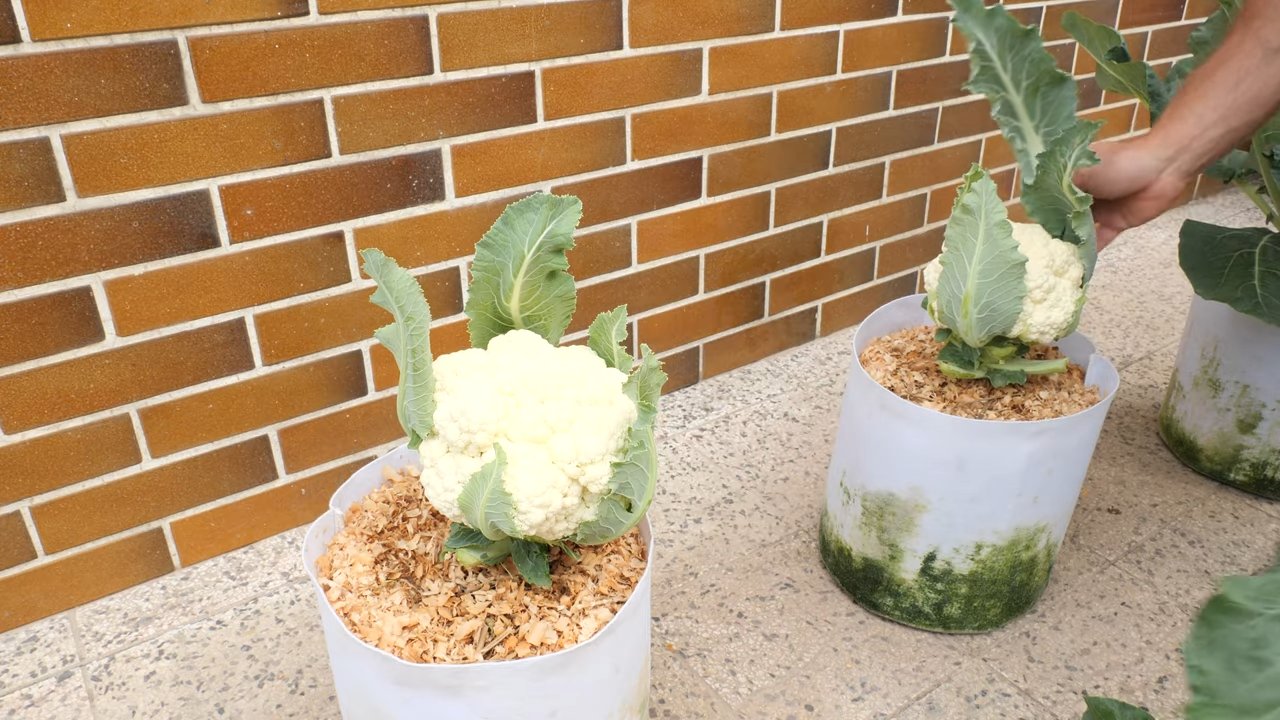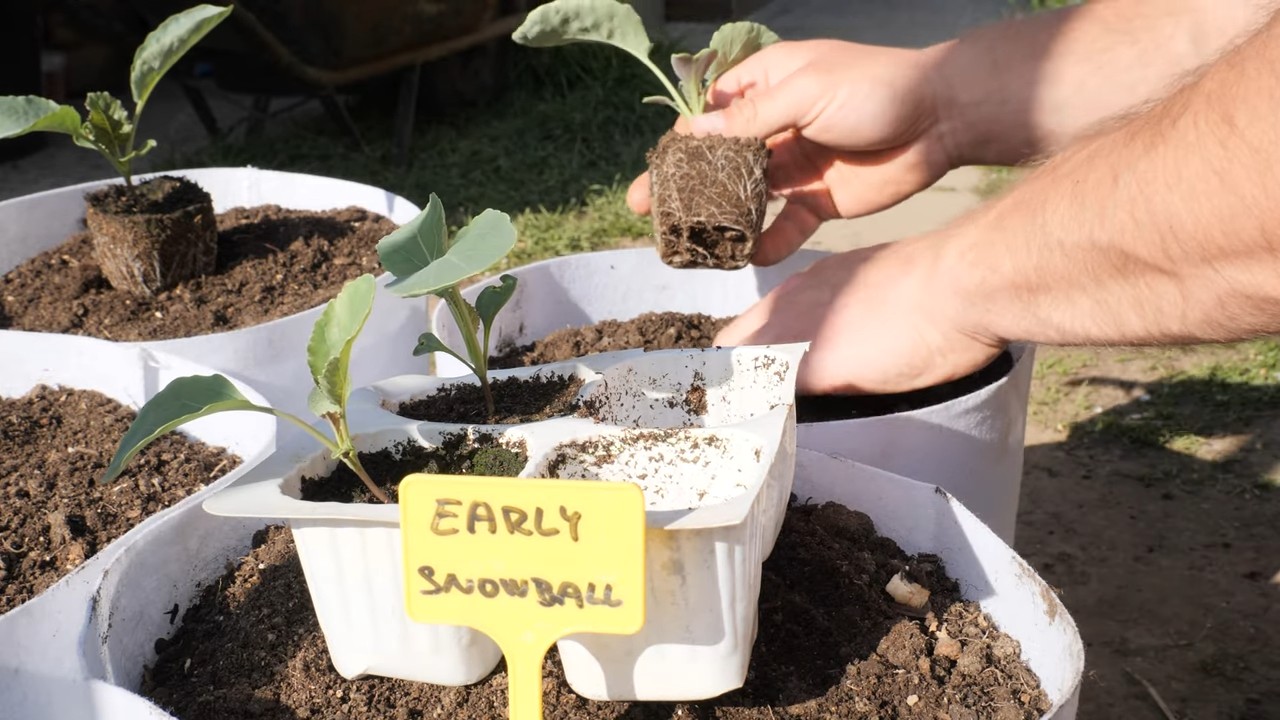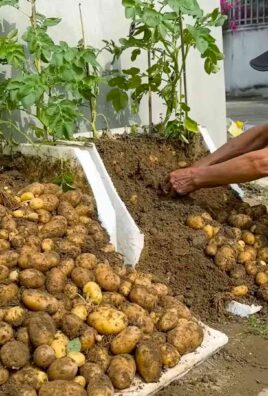Container Cauliflower Growing Tips: Unlock the secrets to bountiful harvests, even without a sprawling garden! Have you ever dreamt of plucking fresh, creamy cauliflower straight from your own backyard, but thought you lacked the space? Well, dream no more! This DIY guide is your passport to cultivating gorgeous cauliflower in containers, transforming even the smallest balcony or patio into a thriving edible oasis.
Cauliflower, a member of the Brassica family, boasts a rich history dating back to ancient times. Originating in the Mediterranean, it was prized by the Romans and has since become a culinary staple worldwide. But you don’t need to be a seasoned farmer to enjoy this versatile vegetable.
In today’s fast-paced world, the desire for fresh, homegrown produce is stronger than ever. Knowing exactly where your food comes from and enjoying the unparalleled flavor of freshly picked vegetables is incredibly rewarding. Plus, growing your own cauliflower in containers is a fantastic way to reduce your carbon footprint and connect with nature. I’m here to show you that with a few simple tricks and hacks, anyone can master container cauliflower growing tips and enjoy a delicious, homegrown harvest. Let’s get started!

Growing Cauliflower in Containers: A Complete DIY Guide
Hey there, fellow gardening enthusiasts! I’m so excited to share my tried-and-true method for growing beautiful, bountiful cauliflower right in containers. Forget thinking you need a huge garden – with a little know-how, you can enjoy fresh, homegrown cauliflower even on a small balcony or patio. Let’s dive in!
Choosing the Right Cauliflower Variety
First things first, not all cauliflower varieties are created equal when it comes to container gardening. You’ll want to opt for compact or dwarf varieties that are specifically bred for smaller spaces. Here are a few of my favorites:
* ‘Snow Crown’: This is a classic, reliable choice that produces medium-sized, pure white heads. It matures relatively quickly, which is a bonus.
* ‘Cheddar’: If you’re feeling adventurous, try ‘Cheddar’! It boasts vibrant orange heads and a slightly sweeter flavor.
* ‘Graffiti’: For a truly unique addition to your garden, go for ‘Graffiti’. It features stunning purple heads that are as beautiful as they are delicious.
* ‘Early White Hybrid’: As the name suggests, this variety matures early, making it a great option for shorter growing seasons.
Preparing Your Container and Soil
The right container and soil are crucial for success. Here’s what I recommend:
* Container Size: Choose a container that’s at least 12 inches in diameter and 12 inches deep. Cauliflower needs plenty of room for its roots to develop. A 5-gallon bucket or a large planter works perfectly.
* Drainage: Make sure your container has adequate drainage holes. Cauliflower hates sitting in soggy soil.
* Soil Mix: Use a high-quality potting mix that’s well-draining and rich in organic matter. I like to amend my potting mix with compost or aged manure for an extra boost of nutrients. Avoid using garden soil, as it can be too heavy and compact for container gardening.
Planting Your Cauliflower Seedlings
Now for the fun part – planting! You can start cauliflower from seed indoors, but I usually prefer to purchase seedlings from a local nursery. It saves time and effort, and you’re more likely to get healthy, vigorous plants.
Here’s my step-by-step planting guide:
1. Water the Seedlings: Before transplanting, thoroughly water your cauliflower seedlings. This will help them adjust to their new home.
2. Prepare the Container: Fill your container with potting mix, leaving a few inches of space at the top.
3. Create a Hole: Dig a hole in the center of the container that’s large enough to accommodate the seedling’s root ball.
4. Gently Remove the Seedling: Carefully remove the seedling from its container, being careful not to damage the roots. Gently loosen the roots if they’re tightly bound.
5. Place the Seedling: Place the seedling in the hole, ensuring that the top of the root ball is level with the soil surface.
6. Fill and Firm: Fill in the hole with potting mix, gently firming the soil around the seedling.
7. Water Thoroughly: Water the newly planted seedling thoroughly, until water drains out of the bottom of the container.
Caring for Your Container Cauliflower
Cauliflower can be a bit demanding, but with the right care, you’ll be rewarded with delicious, homegrown heads.
Sunlight and Watering
* Sunlight: Cauliflower needs at least 6 hours of direct sunlight per day. Place your container in a sunny spot where it will receive plenty of light.
* Watering: Water your cauliflower regularly, especially during hot, dry weather. The soil should be consistently moist, but not soggy. Check the soil moisture by sticking your finger into the soil. If the top inch feels dry, it’s time to water. I usually water deeply every 2-3 days, depending on the weather.
Fertilizing
* Fertilizing: Cauliflower is a heavy feeder, so regular fertilization is essential. Start fertilizing about two weeks after transplanting. Use a balanced fertilizer (e.g., 10-10-10) or a fertilizer specifically formulated for vegetables. Follow the instructions on the fertilizer label. I like to use a liquid fertilizer diluted to half strength and apply it every two weeks. You can also side-dress your plants with compost or aged manure.
Pest and Disease Control
* Pest Control: Cauliflower is susceptible to several pests, including cabbage worms, aphids, and flea beetles. Inspect your plants regularly for signs of infestation. Handpick any pests you find. For more serious infestations, you can use insecticidal soap or neem oil.
* Disease Control: Cauliflower can also be affected by diseases such as black rot and clubroot. To prevent these diseases, make sure your plants have good air circulation and avoid overwatering. If you notice any signs of disease, remove the affected leaves or plants immediately.
Blanching (Optional)
* Blanching: Blanching is the process of covering the developing cauliflower head to prevent it from turning yellow or brown. While not strictly necessary, blanching can result in a whiter, more attractive head. To blanch, simply tie the outer leaves of the plant together over the developing head when it reaches about 3 inches in diameter. Use twine or rubber bands to secure the leaves. Check the head regularly and harvest when it reaches the desired size.
Harvesting Your Cauliflower
Harvest time is the most rewarding part of the process! You’ll know your cauliflower is ready to harvest when the head is firm, compact, and reaches the desired size. The exact size will depend on the variety you’re growing.
Here’s how I harvest my cauliflower:
1. Check for Readiness: Make sure the head is firm and compact.
2. Cut the Head: Use a sharp knife to cut the head from the plant, leaving a few inches of stem attached.
3. Remove Outer Leaves: Remove any yellowed or damaged outer leaves.
4. Enjoy! Rinse the cauliflower head and enjoy it fresh from your garden!
Troubleshooting Common Problems
Even with the best care, you might encounter a few challenges along the way. Here are some common problems and how to address them:
* Small Heads: Small heads can be caused by insufficient sunlight, water, or nutrients. Make sure your plants are getting enough of all three.
* Yellowing Heads: Yellowing heads can be caused by too much sunlight or a lack of blanching. If you’re not blanching, try moving your container to a slightly shadier location.
* Buttoning: Buttoning is when the cauliflower head forms prematurely and remains small. This can be caused by stress, such as extreme temperatures or lack of water.
* Pest Infestations: As mentioned earlier, cauliflower is susceptible to several pests. Inspect your plants regularly and take action to control any infestations.
* Disease: Prevent disease by providing good air circulation and avoiding overwatering.
Extending Your Harvest
To extend your cauliflower harvest, consider succession planting. Plant new seedlings every few weeks to ensure a continuous supply of fresh cauliflower. You can also try growing different varieties with varying maturity dates.
Additional Tips for Success
Here are a few extra tips that I’ve learned over the years:
* Choose the Right Container: As mentioned earlier, the right container is crucial. Make sure it’s large enough and has good drainage.
* Use High-Quality Potting Mix: Don’t skimp on the potting mix. Use a high-quality mix that’s well-draining and rich in organic matter.
* Water Regularly: Cauliflower needs consistent moisture. Water deeply and regularly, especially during hot, dry weather.
* Fertilize Regularly: Cauliflower is a heavy feeder. Fertilize regularly with a balanced fertilizer or a fertilizer specifically formulated for vegetables.
* Protect from Pests: Inspect your plants regularly for pests and take action to control any infestations.
* Be Patient: Cauliflower takes time to mature. Be patient and don’t give up!
Growing cauliflower in containers is a rewarding experience. With a little planning and care, you can enjoy fresh, homegrown cauliflower even if you don’t have a traditional garden. So, get out there and start planting! Happy gardening!

Conclusion
So, there you have it! Growing cauliflower in containers might seem daunting at first, but with these simple tips and a little dedication, you can absolutely cultivate your own delicious, homegrown cauliflower right on your patio, balcony, or even a sunny windowsill. Forget those bland, overpriced heads from the grocery store – imagine the satisfaction of harvesting a crisp, flavorful cauliflower that you nurtured from seedling to harvest.
This isn’t just about saving money; it’s about connecting with your food, understanding the growing process, and enjoying the unparalleled taste of fresh, locally grown produce. Plus, container gardening offers a level of control that traditional gardening often lacks. You can easily move your cauliflower to chase the sun, protect it from unexpected frosts, and keep a closer eye on pests and diseases.
Why is this DIY container cauliflower growing trick a must-try? Because it empowers you to grow your own healthy food, regardless of space limitations. It’s a sustainable practice that reduces your carbon footprint and provides you with a rewarding and educational experience. And let’s be honest, there’s nothing quite like the bragging rights that come with serving a dish made with ingredients you grew yourself!
Don’t be afraid to experiment! Try different varieties of cauliflower to see which ones thrive best in your local climate and container setup. Consider adding companion plants like marigolds or nasturtiums to deter pests naturally. You can even try succession planting, starting new seedlings every few weeks to ensure a continuous harvest throughout the growing season.
Ready to embark on your container cauliflower adventure? We encourage you to give these tips a try. Start small, be patient, and don’t be discouraged by initial setbacks. Gardening is a learning process, and every mistake is an opportunity to improve.
Most importantly, we want to hear about your experiences! Share your photos, tips, and challenges in the comments below. Let’s build a community of container cauliflower enthusiasts and learn from each other. What variety did you choose? What challenges did you face? What successes did you celebrate? Your insights could help other aspiring gardeners achieve their own container cauliflower dreams. So, grab your seeds, your containers, and your gardening gloves, and get ready to experience the joy of growing your own delicious, homegrown cauliflower! This method of container cauliflower growing is not only practical but also incredibly rewarding.
Frequently Asked Questions (FAQ)
What is the best size container for growing cauliflower?
A: Ideally, you’ll want a container that is at least 12 inches in diameter and 12 inches deep. A 5-gallon bucket or a similar-sized pot works well. Cauliflower needs room for its roots to develop properly, and a smaller container can restrict growth and lead to smaller, less healthy heads. Remember that larger varieties might benefit from even larger containers, up to 10 gallons. Ensure the container has adequate drainage holes to prevent waterlogging, which can lead to root rot.
What type of soil is best for container cauliflower?
A: Cauliflower thrives in well-draining, nutrient-rich soil. A good potting mix specifically formulated for vegetables is an excellent choice. You can also create your own mix by combining equal parts of compost, peat moss (or coconut coir), and perlite or vermiculite. Compost provides essential nutrients, peat moss (or coir) helps retain moisture, and perlite or vermiculite improves drainage. Avoid using garden soil in containers, as it can become compacted and doesn’t drain well.
How much sunlight does container cauliflower need?
A: Cauliflower needs at least 6 hours of direct sunlight per day to thrive. Choose a sunny location for your container garden. If you live in a particularly hot climate, some afternoon shade can be beneficial to prevent the plants from overheating. If you don’t have a spot that receives enough natural sunlight, you can supplement with grow lights.
How often should I water my container cauliflower?
A: Water your cauliflower regularly, keeping the soil consistently moist but not waterlogged. Check the soil moisture level daily, especially during hot weather. Water deeply when the top inch of soil feels dry to the touch. Avoid overhead watering, as this can increase the risk of fungal diseases. Instead, water at the base of the plant.
What kind of fertilizer should I use for container cauliflower?
A: Cauliflower is a heavy feeder, so regular fertilization is essential. Use a balanced fertilizer (e.g., 10-10-10) or a fertilizer specifically formulated for vegetables. Follow the instructions on the fertilizer package for application rates. You can also supplement with organic fertilizers like compost tea or fish emulsion. Fertilize every 2-3 weeks during the growing season.
How do I protect my container cauliflower from pests?
A: Common pests that affect cauliflower include cabbage worms, aphids, and flea beetles. Inspect your plants regularly for signs of infestation. You can handpick cabbage worms off the plants or use Bacillus thuringiensis (Bt), a natural insecticide, to control them. Aphids can be washed off with a strong stream of water or treated with insecticidal soap. Flea beetles can be deterred by covering the plants with row covers. Companion planting with marigolds or nasturtiums can also help repel pests.
How do I know when my container cauliflower is ready to harvest?
A: Cauliflower is typically ready to harvest when the head is firm, compact, and about 6-8 inches in diameter. The exact size will depend on the variety. Check the seed packet or plant tag for specific harvesting information. Use a sharp knife to cut the head from the plant, leaving a few leaves attached.
Can I grow cauliflower in containers in hot climates?
A: Yes, you can grow cauliflower in containers in hot climates, but you’ll need to take extra precautions to protect the plants from the heat. Provide afternoon shade, water more frequently, and consider using a light-colored container to reflect heat. Choose heat-tolerant varieties of cauliflower.
Can I grow cauliflower in containers indoors?
A: Yes, you can grow cauliflower in containers indoors, but you’ll need to provide adequate light. Use grow lights to supplement natural sunlight. Ensure the plants receive at least 12-14 hours of light per day. You’ll also need to provide good air circulation to prevent fungal diseases.
What are some good varieties of cauliflower to grow in containers?
A: Some good varieties of cauliflower to grow in containers include ‘Snow Crown,’ ‘Cheddar,’ ‘Graffiti,’ and ‘Early White Hybrid.’ These varieties are relatively compact and well-suited for container gardening. Check with your local nursery or seed supplier for varieties that are best suited for your climate.




Leave a Comment